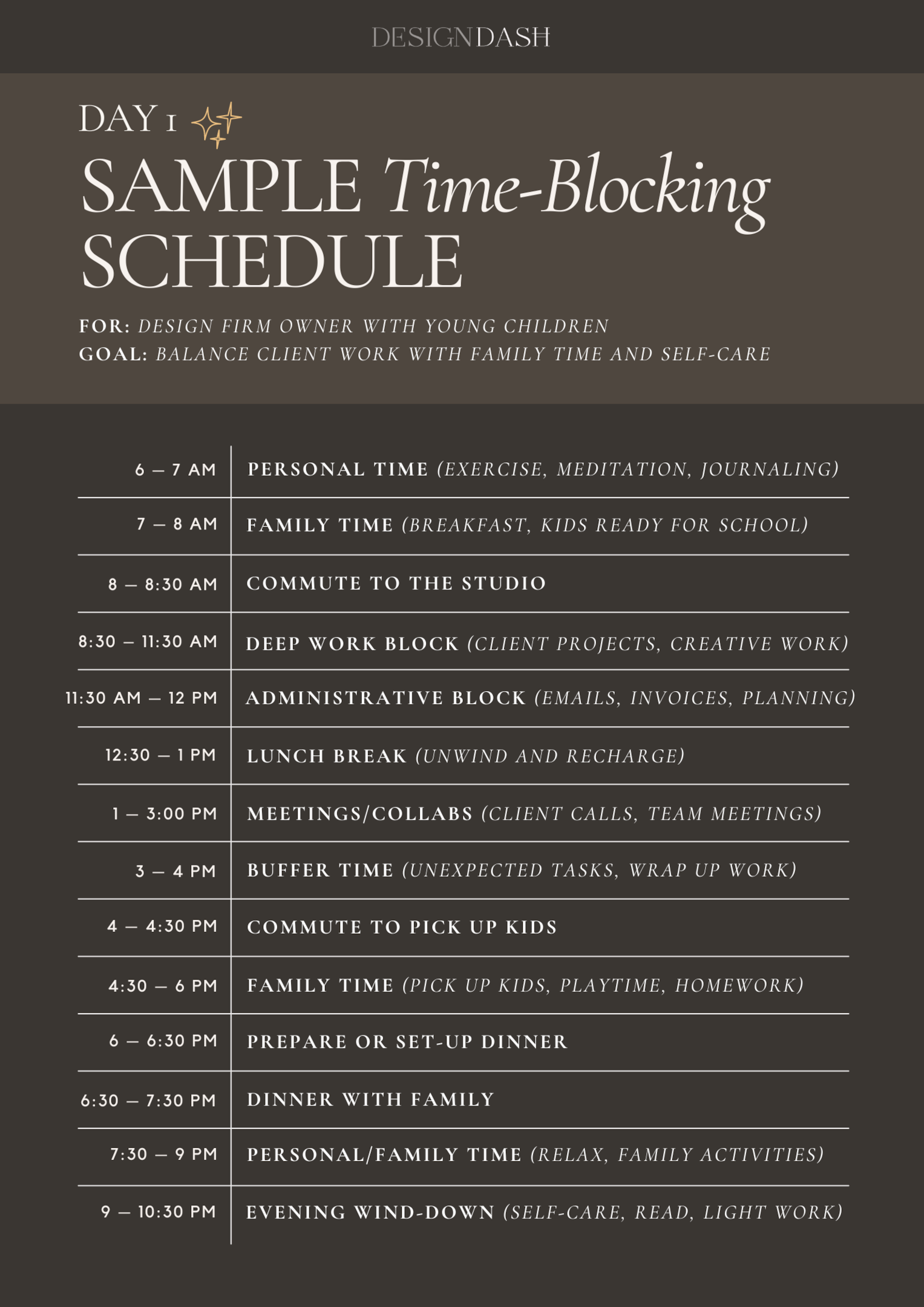
How to Time Block for a More Satisfying, Efficient Workflow
Summary
Time blocking is a powerful productivity technique that helps women entrepreneurs balance the demands of running a creative business and managing family responsibilities. By scheduling specific blocks of time for different tasks, you can boost focus, reduce stress, and ensure time for self-care and family. This method is flexible and adaptable, allowing you to stay organized and productive even when life throws unexpected challenges your way.
Reflection Questions
- How could time blocking help you better manage the competing demands of your business and family life?
- What are the most significant time-wasting activities in your current schedule, and how could time blocking help eliminate them?
- How can you incorporate self-care and personal time into your time-blocked schedule to ensure a balanced life?
Journal Prompt
Reflect on a typical week in your life. How do you currently manage your time between work, family, and personal activities? Write about how time blocking could help you improve your focus, productivity, and overall balance. What changes would you make to your schedule to create a more satisfying and efficient daily routine?
Balancing the demands of running a creative business with family life’s joys (and challenges) can feel like a never-ending juggling act. Between client meetings, project deadlines, school pickups, and family dinners, it’s easy to feel stretched thin. But what if there was a way to bring some order to the chaos? That’s why we love the time-blocking method. This simple yet powerful productivity and time management technique can help you reclaim your schedule, boost your focus, and find that elusive work-life rhythm. For female creative entrepreneurs who wear many hats, creating a time-blocked schedule might just be that secret weapon you’ve been looking for. Let’s explore how this method could transform your daily routine into a more satisfying and efficient workflow that leaves lots of time for family, friends, and hobbies.
What Exactly is Time Blocking?

So, what is time blocking? Think of it as your game plan for the day! Instead of scribbling down a long to-do list and hoping you get through it (we’ve all been there), time blocking is about setting aside specific chunks of time for each task and task batching similar tasks.
9 to 11 AM might be all about client meetings, while 2 to 4 PM is when you tackle that creative project you’ve been excited about. The key here is focus: by dedicating a block of time to one thing, you avoid the dreaded multitasking trap, where nothing gets your full attention.
You’ll start by prioritizing your tasks based on urgency and importance, then creating time blocks where you focus on one thing at a time. These blocks can vary in length—deep work might take 90 minutes, while administrative tasks could be shorter. It’s also essential to include blocks for breaks and downtime to recharge.
To stay organized, categorize your time blocks into areas like work, family, health, and personal development. Don’t forget to build in buffer time between blocks for unexpected delays or transitions as you work on a particular task. While time blocking might seem rigid, it’s quite flexible—you can adjust your blocks as needed throughout the day or week. Using tools like digital calendars or paper planners can help you stay on track, and reviewing your schedule regularly ensures you’re continuously refining your approach to achieve a balanced, productive routine.
The Many Benefits of Time-Blocking

Time blocking isn’t just about being more organized—it’s about giving yourself the gift of focus and peace of mind. When you know exactly what you’re working on and when you can dive in fully, you get more done and feel more accomplished. Plus, say goodbye to decision fatigue and procrastination because your day is already mapped out.
Cutting Context Switching
Time-blocking can also improve your mental health by reducing the need for context-switching. Context switching refers to the cognitive shift that occurs when you move from one task to another, especially when the tasks are unrelated. Each time you switch contexts, your brain needs to refocus, which can be mentally draining and time-consuming. This constant switching can reduce productivity, increase errors, and lead to burnout.
Time blocking directly addresses the issue of context switching by minimizing the need to jump between different types of tasks. When you dedicate blocks of time to one specific task or category of work, you give yourself the space to fully immerse in that activity without the distraction of other responsibilities. This time management strategy improves focus and efficiency and helps maintain mental clarity, allowing you to accomplish more with less stress. By reducing context switching, time blocking helps create a smoother, more satisfying workflow.
Help Managing Multiple Roles

As a woman running a creative firm and juggling family life, you’re basically a superhero! But even superheroes need a little help to manage all the demands on their time. A time-blocked calendar can help.
By setting aside specific chunks of time for your business and family responsibilities, you can make sure that both worlds get the attention they deserve. Imagine having a focused block in the morning to knock out client work, followed by an afternoon dedicated to family time—no more feeling pulled in a million directions at once!
Prioritizing Self-Care and Personal Time

Let’s be real: between work deadlines and family duties, self-care often falls to the bottom of the list. But guess what? Time blocking can change that!
By intentionally scheduling time for valuable daily tasks like self-care, exercise, and hobbies, you’re giving yourself permission to recharge and do the things you love. Whether it’s a morning yoga session or an hour in the evening to dive into that book you’ve been meaning to read, time blocking helps ensure that your well-being isn’t just an afterthought—it’s a priority.
Customizing Time Blocks for Flexibility
Life doesn’t always go according to plan, especially when you’ve got a business to run and a family to care for. The beauty of time blocking is its flexibility. You can design your schedule to adapt to the unexpected, whether that’s a last-minute client request or a surprise school event.
Building in buffer times and being open to shifting your blocks around allows you to stay on top of everything without feeling stressed. Time blocking isn’t about rigid schedules—it’s about creating a structure that supports your dynamic, busy life!
How to Get Started with Time Blocking
Step 1: Assess Your Current Schedule

Ready to dive into time blocking? The first step is to take a good, hard look at your current schedule. It’s time for a little audit! Grab your calendar (or even just a blank sheet of paper) and jot down everything you do in a typical week.
Here’s where it gets fun—start identifying those sneaky time-wasting activities that eat up your day without giving much back. Whether it’s endless scrolling on social media or getting sucked into unproductive meetings, once you spot these time thieves, you can start cutting them out and making room for what truly matters.
Step 2: Identify Priority Tasks
With a clearer schedule, it’s time to figure out what deserves your attention. What big-ticket items drive your business forward and keep your family life running smoothly? These are your priorities! List the most important tasks for work and home, then rank each important task by impact. Setting clear goals here will help you focus your time blocks on what matters most—landing a big client or ensuring you never miss a family dinner.
Step 3: Set Up Your Time Blocks

Now for the main event: setting up your time blocks for the entire day! Think of this as creating your dream schedule, where everything has its place. Start by making blocks for your top priorities—client work, meetings, family time, self-care, and anything else essential.
Fuel your creative fire & be a part of a supportive community that values how you love to live.
subscribe to our newsletter
*please check your Spam folder for the latest DesignDash Magazine issue immediately after subscription

Maybe your mornings are dedicated to deep work and creative projects, afternoons are for meetings, and evenings are about family. Consider how long tasks might take and play around with different time blocks until you find a rhythm that works for you. Remember, the goal is to feel productive and balanced.
Step 4: Find the Right Tools
This time management method is only as good as the tools you use to make it happen. Whether you’re a digital diva or a paper planner enthusiast, there’s a tool out there for you! Digital options like Google Calendar and Trello are great for those who love a bit of tech, while analog methods like planners or bullet journals work wonders for the pen-and-paper crowd. The key is to choose what fits your style and keeps you excited to stick to your schedule. So, go ahead and find your time-blocking sidekick—it will be a game-changer!
Keeping YourSelf on Track: Strategies for Successful Time Blocking

Life is full of surprises; even the best-laid plans can go off course. The secret to successful time blocking is all about flexibility! Don’t stress if something comes up and throws your schedule for a loop—just adjust your blocks and keep moving forward.
Maybe your client meeting ran over or your kid needs some extra help with homework. No biggie! Shift your tasks around and permit yourself to adapt without feeling guilty. The goal is to stay productive while rolling with the punches, so embrace the flexibility and know that you’ve got this.
Accountability and Consistency

Time blocking only works if you stick to it, which means holding yourself accountable. But you don’t have to do it alone! Get your family and team on board by explaining why your time blocks are important.
When everyone knows your schedule, they’re more likely to respect it, which means fewer interruptions. Plus, consistency is key. The more you commit to your time blocks, the more they’ll become a natural part of your routine. So, rally the troops, stay consistent, and watch your productivity soar!
Reviewing and Adjusting Your Schedule
Time blocking isn’t a one-and-done deal; it’s a process that evolves with you. That’s why it’s essential to review your schedule to see how it’s working regularly. Are certain blocks feeling too rushed? Do you need more time for creative work or family activities?
Step back every week or so and assess what’s going well and what needs tweaking. By making small adjustments, you can keep your time blocks fresh and effective, ensuring that your schedule supports your goals and keeps you balanced and energized.
Sample Time Blocking Schedule

Overcoming Common Time-Blocking Challenges
Even with the best time-blocking plans, staying motivated day in and day out can be challenging—especially when the to-do list feels never-ending. The key is to keep your energy and burnout at bay by building in regular breaks and switching things up when needed. Maybe that means a quick walk around the block, a coffee date with a friend, or even five minutes of deep breathing.
It’s also SUPER important to recognize the early signs of burnout, like feeling constantly drained or losing enthusiasm for tasks you usually enjoy. When you spot these red flags, it’s time to pause, reassess your schedule, and maybe even lighten your load. Remember, staying motivated isn’t about pushing through no matter what—it’s about keeping your mental and physical health in check to stay in the game for the long haul.
Dealing with Your Need for Perfection

Ah, perfectionism—the double-edged sword that can either drive us to do our best or completely derail our progress. When it comes to time blocking, it’s easy to fall into the trap of thinking everything has to go exactly as planned. But here’s the thing: life is messy, and schedules sometimes must be flexible. Instead of getting caught up in perfecting everything, focus on making progress.
Did you get through most of your tasks today? Great! Celebrate that win instead of dwelling on what didn’t get done. Remember, the goal of time blocking is to help you manage your time better—not to create a rigid system that stresses you out. Scheduling tasks is supposed to make your day easier—not frustrate you. Embrace the imperfections, keep tweaking your schedule as you go, and give yourself a pat on the back for your progress.
Final Thoughts: Let’s Start Time-Blocking!

By breaking down your schedule into focused chunks, you can boost your productivity, reduce stress, and ensure you’re giving time to the things that matter most—your clients, your kids, or yourself. It’s all about finding that sweet spot where work and life flow seamlessly, leaving you feeling accomplished and balanced at the end of each day.
Ready to try time blocking? It’s easier than you think! Start by mapping out your week, setting those all-important blocks for work, family, and self-care, and see how it transforms your routine. Remember, balance and focus aren’t just pipe dreams—they’re achievable with the right approach. So go ahead, take that first step, and watch how time blocking can make your life a little more organized, productive, and less stressful.

Location:
Remote Challenge
Date:
Starts August 14th — Ongoing
Here’s a fun challenge: try time-blocking for just one week. Yep, just seven days! See how it impacts your productivity, mood, and overall sense of balance. You might be surprised at how much smoother your days start to feel when you have a plan. Consider signing up for our Focus & Flex Challenge to try out time-blocking with the Pomodoro Method before diving in full-throttle.
Once you’ve tried it, we’d love to hear how it went! Share your experience with time blocking—what worked, what didn’t, and how it made you feel. Connect with other women who are on the same journey, and let’s create a community where we all support each other in living our best, most balanced lives.








